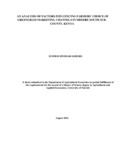| dc.description.abstract | Smallholder farmers in Mbeere South sub-County face crop production and marketing constraints that trap them in a vicious cycle of poverty. Mainstream marketing research and development efforts often focus on the major staples such as maize, rice and wheat, neglecting the traditional crops of high value such as green grams, cowpeas, and sorghum. Most of the traditional crops of high value are produced in the arid and semi-arid lands (ASALs) where they experience many challenges. This study attempted to provide a better understanding of market dynamics of green grams, a traditional crop grown by a resource-poor community, by assessing the factors affecting farmers’ preference for alternative green gram marketing channels. The study addressed two objectives: first, it characterized the existing green gram marketing channels in Mbeere South sub-County in terms of price and marketed volumes. Secondly, it evaluated the factors that influence the choice of the marketing channel in Mbeere South sub-County. To achieve the first objective, descriptive statistics were used to characterize the marketing channels using data collected using a semi-structured questionnaire and focus group discussions. The second objective was achieved by employing a multinomial logit model on survey data involving 266 household in Mbeere South sub-County. The results showed that about 70 percent of farmers in Mbeere South sub-County grew green grams at the time of the survey. On average, each household had 1 to 2 acres of land under green grams production each year, with an average yield of four bags per acre. Farmers used three marketing channels; i.e., rural retailers, wholesalers and assemblers. About 58.2 percent of the farmers sold to rural retailers, 26.9 percent to assemblers and 14.9 percent to wholesalers. Rural retailers offered farmers the highest price at KES 4500 per bag of 90 kg; assemblers KES 4400 and wholesalers KES 4162 for the same bag. The results of multinomial logit showed that farmer’s age (P=0.06), access to credit (p=0.065), price of green grams (p=0.079), and selling as individuals
vi
(p=0.000) positively influenced farmers’ choice of rural assembler marketing channel. The cost of production (p=0.006) and access to marketing information through mobile phones (p=0.001) negatively but significantly influenced the probability of choosing rural assemblers relative to wholesaler channel. Farmers with a higher cost of production could not make a mark-up from selling to assemblers who offered the lowest margins. The rural assembler channel was preferred by older farmers who did not use mobile phones to access market information. Transport costs negatively influenced the choice probability of rural retailer relative to wholesale marketing channels (p=0.000). The gender of the household head (p=0.001), production cost (p=0.000) and use of mobile phone to access marketing information (p=0.019) positively influenced the probability of choosing rural retailer over wholesaler marketing channel. The rural retailer marketing channel was preferred by men and farmers who had access to credit, sold individually, and had higher production cost. This could be because men control the decision on income from agricultural produce and hence would like to sell to channels which give the highest margins. In addition, farmers who sold through this channel received the highest margins making it the most preferred channel. In conclusion, farmers’ choice of marketing channel was determined by the socio-economic, institutional, and farm level factors. Farmers preferred marketing channels where they incurred low transport cost and that offered higher prices plausibly to maximize profits. The study recommends interventions to aim at enhancing market-based signals such as price support by the government. In addition, interventions that lower production cost, e.g., use of improved seed to enhance farm productivity are called for. | en_US |



